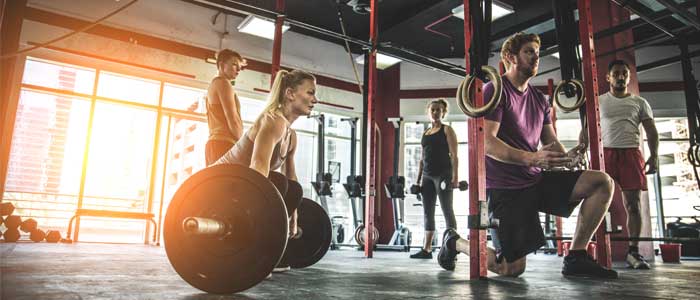How Long Should Your Workouts Really be Lasting?
2nd Apr 20

Deciding how long your workouts should be to see the desired results can be challenging, especially if you’re starting out. The last thing you need is to make mistakes, and worse still, to waste time. To figure out the best answer to it, you need a little bit of homework, and some great advice too.
The best place to start is always with a bit of education. Learning what you want to achieve and the best ways to go about getting there within your means are the foundations of fitness. It’s different for everyone, but a great starting point is with motive. What do you want to achieve, and how much time can you give to it?
Typically, the reasons for training can be split into four different types. This, however, is where the problems lie as each requires different types of training and different workout lengths. It can really be quite confusing.
The best way to tackle it? Let’s look at each one on an individual level. We’re nothing if not thorough after all.
Want to move fast? Jump to the right section below.
Strength & Muscle Building

Muscle building and strength training are up there with the most diverse exercise you can find. There’s much more to it than meets the eye, and you can tackle it from numerous different angles.
Training Type & Workout Plan
One way to get your head around all of this is by looking at different training types and workout plans. There are tonnes of examples out there, all explaining how long your workouts should be, and they’re usually all very different. That’s because different workouts and training types do different things to reach different forms of progressive overload.
Some people like to train with compound full-body workouts. That way, you’re hitting every muscle in your body to some extent every time you exercise. Others like to break it down. Push-pull legs or isolation workout plans mean one day you hit one muscle, and the next a totally different one. These let you really hit each muscle group hard, but it often takes more time and effort. How long your workouts should be are very different for both.
Skill Level & Specificity
This leads straight into a slightly more in-depth point, covering a similar thing. You need to understand your goals even more than you do now. Dig deeper. If you’re just starting out and trying to find your feet to see how best works for you, you will likely find that your workouts will be dramatically shorter than someone who is training for a bodybuilding contest.
The more advanced you become in your training, the more likely you will need to add variation to your workouts and thus take longer. It’s all relative, and there’s no one right answer.
Set Style & Rest Time
This variation doesn’t stop at exercises either. You may well notice that your sets’ style has a huge impact on the length of your workouts. The standard strength training set of 8-12 reps for 4 sets before moving on to the next exercise will be the average time for your workouts. That’s a given.
Once you start adding in supersets with little to no rest time, you’ll see them move dramatically faster. Once you add sets like drop sets or German volume training, you’re going to see the exact opposite. Variation is everything when it comes to strength training.
With all of this in mind, realistically, your workouts will last somewhere between 30 and 90 minutes, with 45-60 being the most common if you are training efficiently and thoroughly. Remember, focus on the workout, not the time it takes.
Weight Loss

Weight loss is the next big goal for a lot of people who are training. It’s a strange mix of factors, much like strength training, but for very different reasons. Your starting point and your end goal will often be the biggest players in this one, but we’ll run through a few others so that you can work it out for yourself.
Different Training Styles
The biggest thing to consider when it comes to training for weight loss is how you will be going about it. The best way to achieve weight loss is to combine a mix of training, from strength training to H.I.I.T. and then well-placed cardio. Finding the balance is difficult sometimes, but they will all take you different amounts of time.
Stamina Limitations
When it comes down to cardio, your stamina will often be a limiting factor for your workout. You can try something like H.I.I.T. to push you to your limit or something like LISS to get the most out of a relaxed but much longer workout. If you are just starting out, your workouts will likely be shorter than you’d like, but progress is the key, and you’ll quickly see it.
Workout Schedule & Diet
When it comes to losing weight, planning is also incredibly important to how your regime will play out. You can often substitute time either way to your workouts depending on your diet, so the smarter you are eating, the more efficient your workouts are going to be, as well as more effective from the right nutrients for training. The amount of time you have in your weeks or even days is also a limiting factor, so work smart as well as hard!
Considering all of that, the workouts will likely vary between 30-45 minutes all in all, and if you give it, you’re all. Full-length cardio workouts like brisk walking, jogging or spinning may take you longer, and strength or HI.I.T. training may be shorter, but you’ll likely see this as an average.
Fitness

General fitness and maintenance are common goals to see in peoples training too. Keeping healthy is an important part of life, and a lot of people realise this and train just for the good of their health rather than trying to make changes in their lives or bodies.
Training Styles
Much like weight loss, your overall fitness training includes a range of different training requirements and styles to fit your needs. You’ll again likely need to combine all of the techniques above and add some stability and flexibility training to keep you in the perfect physical condition.
Current Fitness Levels
Your training will depend massively on your current fitness levels, and you’ll see massive changes to your workout times as you gradually progress until you can train how you would like to, rather than how best to progress. Any injuries or physical limitations often need to be taken into account, though, especially whilst avoiding any additional injuries from your training.
Workout Schedule
This is one of the factors that applies to every type of training no matter what your goal is, but it’s important none-the-less. With fitness training, this is one of the more variable factors in play, as you’ll be very flexible with how often you train depending on how you enjoy exercise. It’s a lot more relaxed than the other goals, so you can generally work at your own pace.
From a general perspective, exercising for your own fitness should be focused on exercising for 20-30 minutes a day, or 150 minutes of moderate exercise a week. This is what makes the fitness goal so flexible as we mentioned, but the NHS gives this as a general guideline
Performance

Completely contradicting the other goals, performance-based training is specific and very complex. You’ll likely be the strictest with this kind of training, and it depends entirely on what you will be performing that controls your workouts.
Performance Requirement Specific
It’s tough to say how long you should be training depending on the activity you will be doing. More often than not, for sports or hobbies, you’ll be training specifically with the sport, as well as for general fitness and stamina improvement, so your training is entirely in your own hands. Running a marathon, for example, will be very different from a hammer throw…
Completely Variable
Putting it simply, if you’re training for explosive activities like sprinting or powerlifting, you’ll be training on average for 45 minutes per workout outside of practising the sport itself.
Stamina or endurance-based activities depend completely on what you’ll be doing and how accustomed to it you need to be. Use your best judgement and ensure you’re in your physical peak; the rest is up to you.
Underlying Factors

Despite how different all of these goals are, there are still some other factors that they will all share that limit your workout times. No matter where, how or why you’re training, these will take their toll so keep them in mind.
Warm Up/Cool Down Time
Warming up and cooling down around your workouts is essential to keep you in the best possible condition and prevent you from injuring yourself, so make sure you’re doing them properly and frequently; otherwise, you may ruin your routine completely. 5-10 minutes should be enough, but don’t forget about them!
Availability/Practicality
The availability of your time will always be a dominating factor as to how long you can give to your training. Find the time to do it properly where possible, but work to your means if not. Pushing yourself too hard can have negative effects, as well as underexercising and demotivating yourself from a lack of progress. Anything is better than nothing.
Individual To The Person
Finally, every single person is different, and their training will reflect this. Whether you’re off to a flying start or stuck in a plateau, as long as you diet properly, train smartly and keep a good attitude, you will see the results. Go at your own pace and work to your goals, not other peoples.

Before beginning any exercise or nutrition program, consult your physician, doctor or other professional. This is especially important for individuals over the age of 35 or persons with pre-existing health problems. Exercise.co.uk assumes no responsibility for personal injury or property damage sustained using our advice.
If you experience dizziness, nausea, chest pain, or any other abnormal symptoms, stop the workout at once and consult a physician or doctor immediately.









